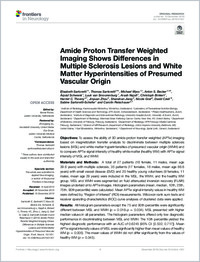Amide proton transfer weighted imaging shows differences in multiple sclerosis lesions and white matter hyperintensities of presumed vascular origin
- Sartoretti, Elisabeth Institute of Radiology, Kantonsspital Winterthur, Winterthur, Switzerland
- Sartoretti, Thomas Laboratory of Translational Nutrition Biology, Department of Health Sciences and Technology, ETH Zurich, Schwerzenbach, Switzerland
- Wyss, Michael Institute of Radiology, Kantonsspital Winterthur, Winterthur, Switzerland - Philips Healthsystems, Zurich, Switzerland
- Becker, Anton S. Laboratory of Translational Nutrition Biology, Department of Health Sciences and Technology, ETH Zurich, Schwerzenbach, Switzerland - Institute of Diagnostic and Interventional Radiology, University Hospital Zurich, University of Zurich, Zurich, Switzerland - Department of Radiology, Memorial Sloan Kettering Cancer Center, New York, NY, United States
- Schwenk, Árpád Institute of Radiology, Kantonsspital Winterthur, Winterthur, Switzerland
- Smoorenburg, Luuk van Institute of Radiology, Kantonsspital Winterthur, Winterthur, Switzerland
- Najafi, Arash Institute of Radiology, Kantonsspital Winterthur, Winterthur, Switzerland
- Binkert, Christoph Institute of Radiology, Kantonsspital Winterthur, Winterthur, Switzerland
- Thoeny, Harriet C. Department of Medicine, University of Fribourg, Switzerland - Department of Radiology, HFR Fribourg-Hôpital Cantonal, Fribourg, Switzerland
- Zhou, Jinyuan Division of MR Research, Department of Radiology, Johns Hopkins University, Baltimore, MD, United States
- Jiang, Shanshan Division of MR Research, Department of Radiology, Johns Hopkins University, Baltimore, MD, United States
- Graf, Nicole Graf Biostatistics, Winterthur, Switzerland
- Czell, David Department of Neurology, Spital Linth, Uznach, Switzerland
- Sartoretti-Schefer, Sabine Institute of Radiology, Kantonsspital Winterthur, Winterthur, Switzerland
- Reischauer, Carolin Department of Medicine, University of Fribourg, Switzerland - Department of Radiology, HFR Fribourg-Hôpital Cantonal, Fribourg, Switzerland
- 10.12.2019
Published in:
- Frontiers in Neurology. - 2019, vol. 10, p. 1307
English
Objectives: To assess the ability of 3D amide proton transfer weighted (APTw) imaging based on magnetization transfer analysis to discriminate between multiple sclerosis lesions (MSL) and white matter hyperintensities of presumed vascular origin (WMH) and to compare APTw signal intensity of healthy white matter (healthy WM) with APTw signal intensity of MSL and WHM.Materials and Methods: A total of 27 patients (16 female, 11 males, mean age 39.6 years) with multiple sclerosis, 35 patients (17 females, 18 males, mean age 66.6 years) with small vessel disease (SVD) and 20 healthy young volunteers (9 females, 11 males, mean age 29 years) were included in the MSL, the WMH, and the healthy WM group. MSL and WMH were segmented on fluid attenuated inversion recovery (FLAIR) images underlaid onto APTw images. Histogram parameters (mean, median, 10th, 25th, 75th, 90th percentile) were calculated. Mean APTw signal intensity values in healthy WM were defined by “Region of interest” (ROI) measurements. Wilcoxon rank sum tests and receiver operating characteristics (ROC) curve analyses of clustered data were applied.Results: All histogram parameters except the 75 and 90th percentile were significantly different between MSL and WMH (p = 0.018–p = 0.034). MSL presented with higher median values in all parameters. The histogram parameters offered only low diagnostic performance in discriminating between MSL and WMH. The 10th percentile yielded the highest diagnostic performance with an AUC of 0.6245 (95% CI: [0.532, 0.717]). Mean APTw signal intensity values of MSL were significantly higher than mean values of healthy WM (p = 0.005). The mean values of WMH did not differ significantly from the values of healthy WM (p = 0.345).Conclusions: We found significant differences in APTw signal intensity, based on straightforward magnetization transfer analysis, between MSL and WMH and between MSL and healthy WM. Low AUC values from ROC analyses, however, suggest that it may be challenging to determine type of lesion with APTw imaging. More advanced analysis of the APT CEST signal may be helpful for further differentiation of MSL and WMH.
- Faculty
- Faculté des sciences et de médecine
- Department
- Médecine 3ème année, Master en médecine
- Language
-
- English
- Classification
- Biological sciences
- License
-
License undefined
- Identifiers
-
- RERO DOC 328011
- DOI 10.3389/fneur.2019.01307
- Persistent URL
- https://folia.unifr.ch/unifr/documents/308312
Other files
Statistics
Document views: 108
File downloads:
- pdf: 245
- Supplementary material: 53

